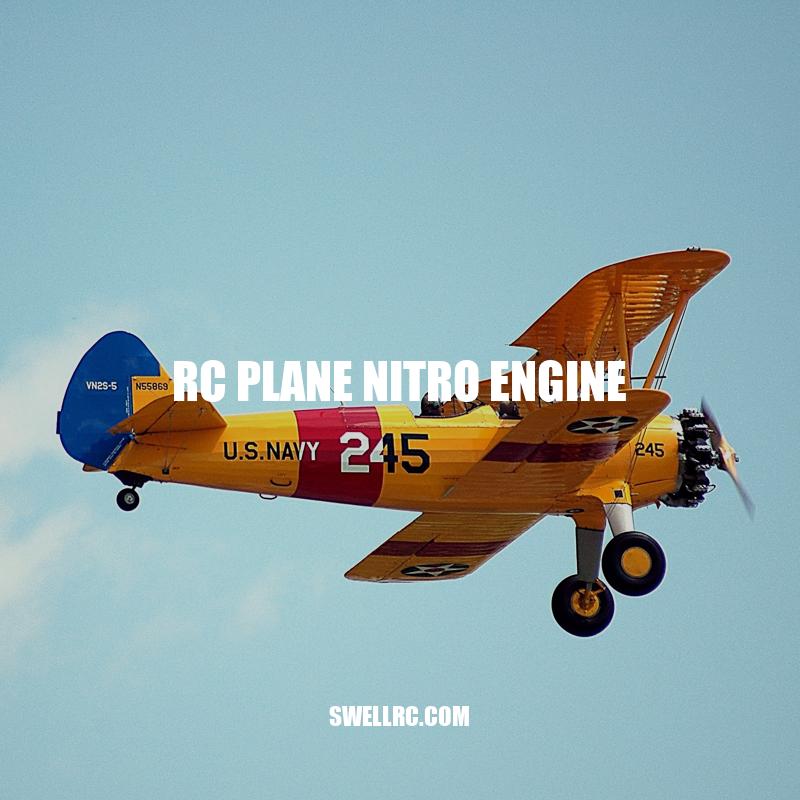Ultimate Guide to RC Plane Nitro Engines
If you’re a remote control (RC) plane enthusiast, you know that there are several types of engines available for powering your plane. While electric motors are relatively common, they may not always provide the power and duration that more advanced flyers need. For those looking to move beyond the limitations of electric-powered planes, nitro engines offer a compelling alternative. With their distinctive sound, impressive power, and extended runtimes, nitro engines are a popular choice for advanced hobbyists and serious competitors alike. In this article, we’ll delve into everything you need to know about RC plane nitro engines, including how they work, their benefits, and tips for maintaining them. Whether you’re new to the world of nitro engines or looking to improve your skills, we’ve got you covered. So, let’s get started!
The Benefits of Nitro Engines
When considering whether to upgrade to a nitro engine, it’s essential to understand the advantages of this popular powering option. Here are some benefits of nitro engines:
- More power: Nitro engines offer more horsepower than electric motors, allowing for advanced maneuvers and high-speed flights.
- Longer flight times: Nitro engines typically provide longer flight times than their electric counterparts, making them ideal for extended flights and competitions.
- Sensory experience: The distinctive sound and smell of nitro engines add a unique sensory element to the flying experience.
- Fun and challenging: Operating a nitro engine can be a fun and challenging experience for hobbyists and competition flyers alike.
For those interested in upgrading to nitro engines, there are several options available for purchase online. Many hobby shops, such as Horizon Hobby and NitroPlanes, offer a wide selection of nitro engines. It’s important to carefully research and compare products to ensure you are selecting the best engine for your RC plane. Additionally, there are several online forums and communities dedicated to nitro engine flying, where hobbyists can share tips, troubleshoot issues, and connect with other enthusiasts.
What is the function of the nitro engine?
The main function of a nitro engine is to power remote-controlled cars, boats, and aircraft. These engines use a mixture of nitromethane, methanol, and oil for fuel, which is ignited by a glow plug to create power. The nitro engine delivers high performance and speed, making it a popular choice for hobbyists and professional racers alike. To learn more about nitro engines and related products, websites such as rcplanet.com and nitrorcx.com offer a wide range of options and information.
How Nitro Engines Work
Nitro engines have a unique design that allows them to generate the necessary power to fly RC planes. Here’s how they work:
- Fuel mixture: Nitro engines use a mixture of nitromethane, methanol, and oil for fuel, which is drawn into the combustion chamber through a carburetor.
- Air mixture: Air is also drawn into the combustion chamber through the carburetor and mixed with the fuel, creating a flammable mixture.
- Ignition: A glow plug ignites the fuel and air mixture, causing it to rapidly expand and push a piston.
- Propulsion: The piston drives a crankshaft, which rotates the propeller and powers the plane through the air.
It’s important to note that nitro engines require special care and attention to maintain their performance. Here are some additional facts to keep in mind:
| Nitro Engine Facts |
|---|
| Nitro engines are typically louder than electric engines, producing a characteristic high-pitched whine. |
| Nitro engines require regular maintenance, including cleaning the air filter, fuel filter, and spark plug. |
| Nitro fuel is highly flammable and should be handled with caution and stored in a safe place away from heat or flame. |
| Nitro engines require a break-in period before optimal performance can be achieved. |
For more information on nitro engines and their operation, check out online resources such as RC Universe or RC Groups. These websites offer a wealth of information on nitro engines, as well as forums and communities where hobbyists can connect and share their experiences.
What is the difference between a gas engine and a nitro engine?
Gas engines and nitro engines are two types of internal combustion engines used in radio-controlled vehicles. The main differences between the two are the fuel type and the ignition method.
Gas engines are powered by gasoline and use a spark plug to ignite the fuel. They are larger and heavier than nitro engines, but they produce more power and have a longer runtime. Gas engines are best suited for large-scale vehicles such as airplanes and boats.
Nitro engines, on the other hand, use a mixture of nitromethane, methanol, and oil as fuel. They have a smaller size and weight and use a glow plug to ignite the fuel. Nitro engines are known for their high RPMs and acceleration, making them ideal for smaller-scale vehicles such as cars and trucks.
In summary, gas engines are best for larger vehicles that need more power and longer runtime, while nitro engines are best suited for smaller vehicles that require high acceleration and speed.
For more information on gas and nitro engines and other RC products, check out websites such as Horizon Hobby and RC Planet.
Maintenance Tips for Nitro Engines
To keep your RC plane nitro engine running smoothly, it’s essential to perform regular maintenance. Here are some tips to help you care for your engine:
- Check the air filter: The air filter prevents dirt and debris from entering the engine and should be checked regularly. If the filter is dirty, clean or replace it as needed.
- Check the fuel filter: The fuel filter prevents debris from entering the fuel line and should be checked before each flight.
- Check the spark plug: The spark plug ignites the fuel and air mixture and should be checked for signs of damage or fouling. Replace the spark plug if necessary.
- Follow the manufacturer’s instructions: Different engines may have specific break-in periods or maintenance requirements. Check the instruction manual for your engine and follow the recommended procedures.
- Store the engine properly: Nitro fuel can evaporate over time, so it’s essential to store the engine in a cool, dry place and use a fuel stabilizer if the engine will not be used for an extended period.
By following these maintenance tips, you can keep your RC plane nitro engine performing at its best. It’s important to remember that nitro engines require a bit more attention than other types of engines, but the improved performance and flying experience are worth the extra effort.
In conclusion, nitro engines offer a unique combination of power, performance, and sensory experience that makes them popular among RC plane enthusiasts. However, they require specific care and attention to maintain their performance. By understanding how they work and following proper maintenance procedures, you can enjoy the benefits of a nitro engine and take your flying skills to new heights.



